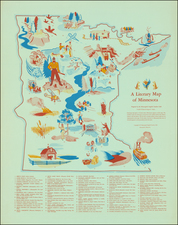This is the second state of Eleanor Hall's map of the area centered on Lake Champlain, showing the region from northwesternmost Massachussetts to Quebec. The map abounds with pictographs representing historical events, famous figures, industries, and other points of interest about the region. Twenty pieces of text surround the work describe the history of the region, focusing primarily on the colonial and revolutionary periods.
As noted on the La Jolla Map Museum Website:
Hall’s history map of the Champlain-Hudson Valley, first published in 1934, is one of nine “Romance Maps” published after the inspiration of Jospehine W. Wickser, who had published “A Romance Map of the Niagara Frontier” in 1931. “Like Wickser’s “Niagara Frontier”, Hall’s map focused on the Indian, French, British, and American periods. The title cartouche displayed portraits of French explorer Samuel de Champlain and military leaders Marquis de Montcalm, General John Burgoyne, General Philip Schuyler, and Commander Thomas Macdonough. Hall was particularly concerned with defining the regional extent of her map. Faced with the narrative problem of telling a story over space, Hall used Burgoyne’s disastrous military campaign as the major historical event that defined the boundaries of her map. From the Richelieu River in the north to Albany in the south, Hall told the multiple, sometimes overlapping stories of the Champlain and Upper Hudson valleys during the colonial and early republic periods… Like many creators of pictorial maps, Hall researched and compiled the content of her map, then hired an artist to draw the illustrations and cartography. Wickser had worked with Carlo Nisita on two maps and recommended him to Hall” (Hornsby).
This map follows very closely after "A Romance Map of the Niagara Frontier," not only in choice of subject as mentioned but also in layout. The two maps look nearly identical save in subject matter. It is clear that both were produced as part of the same movement in the early Golden Age of Pictorial Maps, and both sought to blend history and geography in a novel way.
Of particular interest in this area are the depictions of the Revolutionary War and War of 1812, both of which saw significant fighting in the area. An inset shows the battle plans for the battle of Valcour Island and the initial American blockade. This 1776 battle would be the first naval engagement between Britain and the United States and resulted in a British victory. The Battle of Plattsburgh is of course also shown, which lead to an American victory, the end of the War of 1812, and was likely the last naval engagement between British and American forces.
Of course, many other aspects of the region are pictured in the map. The map informs about the history of zoo animals in the region, vice-presidents, mining, and much, much more. In all, this is a fascinating and attractive pictorial map of an idyllic and historical part of New England.









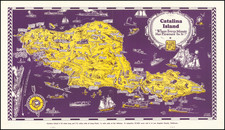
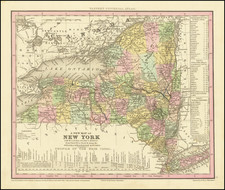
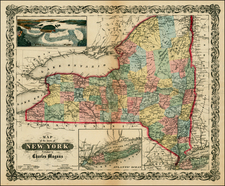
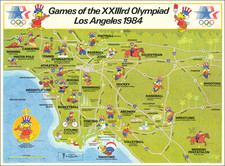
![[Aloha - Christmas Post Card]](https://storage.googleapis.com/raremaps/img/small/67516.jpg)
